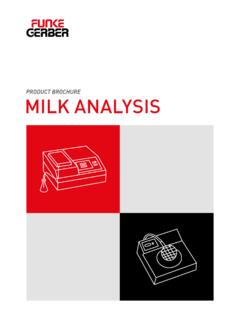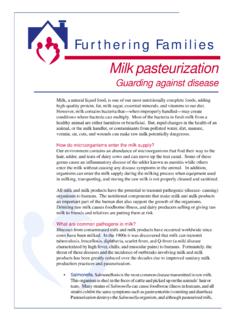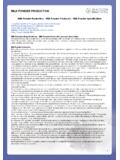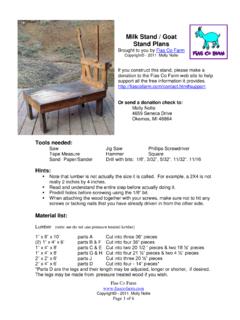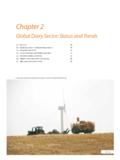Transcription of What is the cost of producing milk? - European …
1 Calculation of milk production costs based on the Farm Accountancy Data Network (FADN) in Belgium, Denmark, France, Germany, NetherlandsResults for 2016 Cost trends and milk price comparison since 2010 What is the cost of producing milk ?2 What is the cost of producing milk ?Milcherzeuger Interessengemeinschaft (MIG) Rue de l Eglise 24, B-6280 Villers-Poterie Phone: +32 470 473 340 e-mail: Milch Board Stresemannstra e 24, D-37079 G ttingen Phone: +49 551 507 6490 e-mail: af Danske M lkeproducenter (LDM) Karetmagervej 9, DK-7000 Fredericia Phone: +45 762 079 63 e-mail: des Producteurs de Lait Ind pendants (APLI) 5, Impasse du Mar chal, F-55700 Stenay-France Phone: + 33 679 620 299 e-mail: des Producteurs de Lait (OPL) 1, Impasse Marc Chagall, F-32022 Auch Cedex 9 Phone: +33 473 531 089 e-mail: milk Board (FMB) FMB Grand Ouest 14, rue de Normandie, F-35133 Luitr Phone: +33 680 285 182 e-mail: Bassin Normand Le Bourg, F-14260 Jurques Phone: +33 6 81 01 79 09 email: Dairymen Board (DDB) Gedempte Schuinesloot 3, NL-7776 PS Slagharen Phone: +31 630 105 890 e-mail: :CONTRACTING ENTITY:PARTICIPATING ORGANISATIONS.
2 B ro f r Agrarsoziologie und Landwirtschaft (BAL), part of the network Die Landforscher Heiligenst dter Str. 2, D-37130 Gleichen Phone: +49 559 292 7567 e-mail: ANALYSIS:All studies and brochures on milk production costs in different EU Member States can be found on the EMB website: , EMB 2017 European milk Board asbl (EMB) Rue de la Loi 155, B-1040 Brussels Phone: +32 2 808 1935 e-mail: .. 4 Synopsis milk production costs in 2016 in five European milk - producing countries .. 5 Details about milk production in 2016 .. 6 Forecast .. 8 milk Production Costs 2016 .. 10 Belgium .. 11 Denmark .. 12 France .. 13 Germany .. 14 Netherlands .. 15 Cost study methodology and data .. 16 Timely and regular the need for information about current costs .. 16 The labour cost of milk production sufficient recognition is the need of the day.
3 17 How many hours does it take to run a dairy farm? .. 18 Overview of publications on milk production costs in Europe .. 22 Table of Contents4 What is the cost of producing milk ?Knowledge about the evolution of costs in European milk production directly affects how well and how realistically we can represent and understand devel-opments on the dairy market. The lack of this kind of over-view in the sector sparked the idea of a cost study in 2011, as something that would provide regular updates on cost developments in different European countries and would be available to all stakeholders EU-wide. A further aim of this longitudinal study was to make a contribution to mapping the influence and effect of the Common Agricultural Policy on national and regional structures. In 2012 and against this backdrop, the dairy farmer associations within the European milk Board (EMB) commis-sioned the Farm Economics and Rural Studies Office (BAL) of the Die Landforscher network to carry out a regular study of milk production costs.
4 These calculations are based on official representative data for the most important milk -pro-ducing countries in the EU. Dairy farmer associations from seven European countries (Belgium, Denmark, Germany, France, Luxembourg, Italy and the Netherlands) are currently participating in this joint project. The cost of milk production in the respective EU Member States is calculated using a common methodology and is regularly updated on behalf of these associations. The current and past economic problems faced by milk producers cannot be understood without considering how costs have developed on farms. Evaluating the economic situation on dairy farms by only looking at milk prices is very short-sighted. Regularly updated cost development studies based on universally applicable, representative data can provide transparent insight about the overarching economic situation of milk producers to political decision-makers as well as the public and different economic partners.
5 Furthermore, the accurate and systematic observation of the evolution of production costs is very useful to farmers, as they can adapt their economic behaviour to dairy market trends and thus strengthen their position: Since the imple-mentation of the EU milk Package in 2012, dairy farmers can use the option of pooling to form producer organisations, in order to collectively negotiate milk prices with the processing industry. Reliable information about production costs is an important factor in this of 2013, the results of the milk production cost studies carried out in different European countries have been reg-ularly published in the BAL s What is the cost of producing milk ? reports. These documents include detailed figures and conclusive facts about the situation and evolution of costs on dairy farms of different sizes and in different regions of the EU. For readers interested in a quick overview, the par-ticipating dairy farmer associations also publish brochures with a summary of the most important facts and conclusions, which is complemented by a data sheet published by the EMB that provides a concise synopsis of the figures.
6 You can find the full list of publications at A comprehensive list of all publications is included on the last page of this of milk production costs in Belgium, Denmark, France, Germany, NetherlandsThe cost calculations in the joint report document the minimum farm gate price that must be paid to farmers to ensure that production costs are covered including appropriate remuneration for farmers themselves as well as their contributing family analysis of milk production costs up to 2016 is cur-rently available for five important milk - producing countries Belgium, Denmark, Germany, France and the Netherlands. More than half (53%) of the total EU milk volume is pro- duced in these five countries in 2016, it amounted to more than 80 million the same year, milk production costs in these countries were between and cents per kilogram. The farm gate price, however, was only between and cents per kilogram. This huge gap between costs and prices led to a shortfall of up to 35%.
7 Synopsis milk production costs in 2016 in five European milk - producing countriesMilk- producing countries:BelgiumDenmarkFranceGermanyNet herlandsProduction costs (end total) gate shortfall35%28%26%32%33%Table 1: milk production costs and farm gate prices in 2016 in five European countries in cents per kilogram6 What is the cost of producing milk ?CountryArea in hectaresDairy cowsMilk yield (kg)Total Annual Work Units (AWU)Family Annual Work Units (FAWU)Belgium53707, , , , , countryBelgiumDenmarkFranceGermanyNether landsInput costs (seeds, fertilizers, plant protection products, bought-in feed, cost of equipment & machine maintenance and energy) operating costs (other specific costs for plant and animal production and all non-specific costs like labour, other general costs, paid wages, rent, interest and taxes in 2015) production costs in total (paid costs) , from beef production (deduction) 2: Dairy farm structure (average farm in 2015)Table 3: Composition of milk production costs in cents per kilogramDetails about milk production in 2016 The herd size of the surveyed dairy farms varied from an average 59 to a maximum 165 dairy cows on an area of 51 to 157 hectares.
8 Annual milk yields were between 6,949 and 9,585 kilograms. much higher number of cows. Danish dairy farms show the highest figures in terms of area, herd size and milk yield. The high proportion of hired labour in Denmark stands out. The average dairy farm in France has a comparatively large area with a smaller dairy herd. The available area on Dutch farms, on the other hand, is very small in relation to the German and Belgian dairy farms are very similar in terms of milk yield and herd size. However, Belgian dairy farms show a greater number of family farms. Continue reading on the next page7 Calculation of milk production costs in Belgium, Denmark, France, Germany, NetherlandsTable 4: Shortfall in incurred production costs 2016 in cents per kilogramMilk- producing countryBelgiumDenmarkFranceGermanyNether landsProduction costs minus revenue from variable milk production (deduction) production costs (end total) costs (paid costs post deduction of revenue from beef) gate in incurred production 2016, dairy farms in all countries incurred significant losses without exception.
9 Dairy farmers were short cents to cents per kilogram (Belgium and Denmark, The cost of inputs contributing to production costs, seeds, fertilizers, plant protection products, bought-in feed, machine and equipment maintenance as well as energy, was between and cents per kilogram in the five production countries and thus quite similar. These cost headings have been extrapolated to the year 2016. For home-grown fodder (hay, silage), the costs for the required seeds, fertilizers and plant protection products as well as other costs for crop production are production costs were first reported for all cattle on the farm, the revenue from bovine animal production ( from the sales of calves, fattening and breeding animals) was deducted in the next step. This gives us the production costs for milk alone. respectively) to even cover their incurred production costs. Remuneration for self-employed dairy farmers is not even considered in these figures!
10 Together with general operating costs (between and cents) and post deduction of revenue from bovine animal production, the subtotal for production costs is between cents per kilogram in Belgium and cents per kilogram in Denmark. These are costs incurred by the farm for milk production alone they do not in-clude the cost of family labour. Simply due to the cost of depreciation, interest and wages to the tune of 14 cents, the incurred production costs in Denmark are compara-tively very is the cost of producing milk ?The calculation only considers those operational costs that can be traced back to milk production on specialised milk farms (see Allocation Legend in Calculation Diagram, p. 20/21). All costs are net values excluding value-added tax and refer to a milk equivalent with 33g protein and 40g labour costs for self-employed family dairy farms are included in the calculation using the wage variable and account for cents (Denmark) to cents (Belgium) per kilogram of milk produced.


